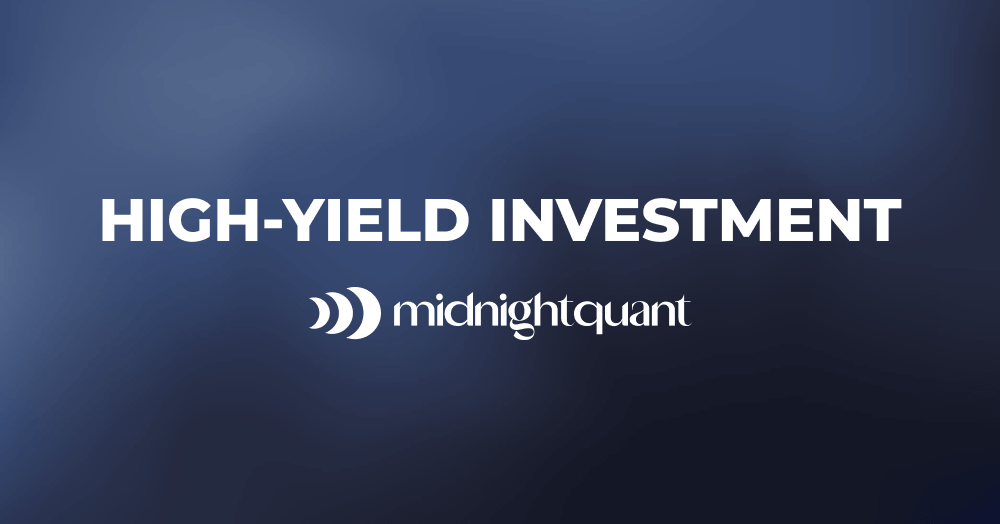The Ultimate Guide to a Bulletproof Investment Strategy: Proven Tactics for Long-Term Wealth
Learn the key investment principles that successful investors use to build wealth while minimizing risk. Discover how MidnightQuant Finance helps optimize your portfolio.

The Ultimate Guide to a Bulletproof Investment Strategy: Proven Tactics for Long-Term Wealth
"The stock market is a device for transferring money from the impatient to the patient." – Warren Buffett
Building long-term wealth isn't about chasing trends—it's about strategy, discipline, and risk management.
In this guide, we’ll reveal battle-tested investment tactics to maximize returns while protecting capital. Plus, we’ll show how MidnightQuant Finance offers an industry-leading 12.30% APY vault with monthly payouts.
1. Define Your Investment Goals with Clarity
A solid investment strategy starts with a plan. Ask yourself:
- Are you investing for passive income, retirement, or capital appreciation?
- What’s your risk tolerance? (Low, Medium, High)
- What’s your time horizon? (Short, Medium, Long-term)
Example Goal-Setting Table
| Goal Type | Time Horizon | Suggested Assets |
|---|---|---|
| Passive Income | 3-5 Years | High-Yield APY Vaults, Dividend Stocks |
| Wealth Growth | 10+ Years | Stocks, ETFs, Real Estate |
| Retirement | 20+ Years | Index Funds, Bonds, REITs |
MidnightQuant Finance offers a reliable way to generate passive income with its 12.30% APY vaults, paid out monthly.
2. Master the Art of Portfolio Diversification
A diversified portfolio reduces risk while maintaining growth.
A good balance includes:
- Equities (Stocks & ETFs) → Long-term capital growth
- Fixed Income (Bonds & APY Accounts) → Stability during downturns
- Alternative Investments (Crypto, Real Estate, AI Funds) → High-growth potential
Comparison: Traditional vs. Optimized Portfolio
| Asset Type | Traditional Portfolio | Optimized for Growth |
|---|---|---|
| Stocks & ETFs | 60% | 50% |
| Bonds & Fixed Income | 30% | 20% |
| Alternative Investments | 5% | 10% |
| High-Yield APY Accounts | 5% | 20% (MidnightQuant) |
Why it works?
- Stocks fuel long-term growth
- Bonds offer stability
- APY vaults compound monthly interest
- Alternatives hedge against market fluctuations
MidnightQuant’s vaults integrate seamlessly into a diversified portfolio for steady, high-yield returns.
3. Leverage APY Investments for Passive Income
What is APY?
Annual Percentage Yield (APY) is the true return on an investment, factoring in compounding interest.
Best APY Platforms in Europe (2025)
| Platform | APY % | Payouts | Min. Deposit | Risk Level |
|---|---|---|---|---|
| MidnightQuant Finance | Up to 12.30% | Monthly | €1000 | Low |
| Revolut | Up to 2.59% | Monthly | €1 | Low |
| N26 | Up to 2.50% | Monthly | €1 | Low |
| Trade Republic | 2.50% | Monthly | €1 | Low |
Why MidnightQuant Wins:
- Highest APY (12.30%) in Europe
- Monthly compounding for better returns
- No market volatility risk
4. Smart Risk Management: Protecting Your Wealth
Investing is not just about gains—it’s about avoiding losses.
Risk Management Checklist
- Stop-Loss Orders → Limit losses in volatile assets
- Portfolio Rebalancing → Adjust allocations as markets shift
- Diversification → Avoid overexposure to one asset class
- Liquidity Planning → Ensure access to cash in emergencies
MidnightQuant’s investment approach minimizes risk by focusing on stable, high-yield, non-volatile APY vaults.
5. The Power of Compound Interest: Small Gains → Big Wealth
Einstein called compound interest "the 8th wonder of the world."
Here’s why:
€10,000 Investment Growth at 12.30% APY
| Year | Value (€) |
|---|---|
| 1 | 11,230 |
| 5 | 18,160 |
| 10 | 32,670 |
| 15 | 58,810 |
MidnightQuant’s monthly payouts accelerate this growth, outperforming traditional savings accounts.
Conclusion: Build Your Future with a Bulletproof Strategy
A successful investment strategy combines goal-setting, diversification, risk management, and compound growth.
MidnightQuant Finance provides an industry-leading 12.30% APY vault with monthly payouts, making it an ideal passive income solution.
